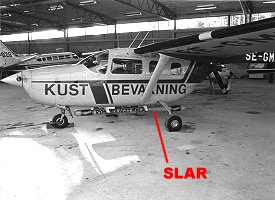|
Table of contents
Go
to Part 1: Ancient history - 1972: How it all began
Part 2: The first decade: 1972 - 1982:
The sky is no limit
Go to part 3: The second
decade: 1982 - 1992: Making dreams come true
Go to Part 4: New horizons:
1992 - 1997: Change in all things is sweet
Part 2: The first decade: 1972 - 1982: The sky is no limit
Place your betsGo to Part 3: The second decade: 1982 - 1992: Making dreams come true
PCM, boost phase guidance and other fancy stuff - rejuvenating sounding rocket technology
A travelling salesman story
The Russians are coming!
Microgravity research - the sounding rocket pioneers again!
Remote sensing
A big ear in the north
World champions within a week?
A 4 % Swedish satellite
Maritime Surveillance
Multiply by division
Going into orbit
Nordsat
The Big Leap
Viking
Tele-X
The 10-year jubilee
The sky is not the limit
Note: A more complete account of SSCís first decade can be found in "The Sky is Not the Limit"; the chronicle by Sven Grahn and Claes-Göran Borg for our 10-year jubilee in 1982. The following is largely a condensed version of their text, with some additional material.
The first decade
SSC was only a few weeks old when it was thrown into its role as industrial policy consultant for space matters. ESAís big programmes were about to start, and major decisions about Swedish participation in the optional programmes had to be made by the Government.
The U.S. offered its "post-Apollo" programme for European participation. It was proposed that ESA should develop a "Space Tug" for transportation of satellites between low and high orbits. This offer was soon withdrawn. It was then proposed that a "Sortie Module" - a laboratory later renamed "Spacelab" - to be carried by the Space Shuttle should be developed by ESA. In addition, there were plans for applications satellite programmes: the OTS telecommunications satellite and the Meteosat weather satellite.
Finally, there was a heated debate on whether, and if so how, a European launch vehicle should be developed, following the debacle of the ELDO launch vehicle. It never achieved orbit, and the ELDO organisation was dissolved when ESA was created.
The decision to develop a new European launcher was almost forced upon ESA members when the U.S. refused to guarantee to launch European operational satellites. France offered to lead the development of a new vehicle, which in their version was known as L3S. The U.K. favoured an alternative development and refused to participate substantially in L3S.
Swedish industry of course wanted Sweden to participate in everything, at the highest possible level of contribution. The goal of the Swedish companies was simple: to try to obtain subsystem or equipment development contracts that represented as much high-technology content as possible! If choices had to be made, Saab favoured participation in Spacelab and Meteosat, Ericsson in OTS, and Volvo Flygmotor in L3S.
 On
the advice of SSC, SBSA decided to "sacrifice" Spacelab in order to achieve
a substantial participation in L3S, soon to be known as Ariane. While
we at SSC recognised the challenging tasks for industry in developing
Spacelab, we thought that Spacelab might turn out to be a "one-shot" development,
while Ariane offered the prospect of long-term follow-on production -
which might not have to be financed out of the space budget. Flygmotor
won the contract to deliver the combustion chambers for the main rocket
engine of Ariane, and Saab the onboard computer for the inertial guidance
system. So, Swedish-built units both propel and guide Ariane! - Important
tasks were also found for Swedish industry in OTS and Meteosat.
On
the advice of SSC, SBSA decided to "sacrifice" Spacelab in order to achieve
a substantial participation in L3S, soon to be known as Ariane. While
we at SSC recognised the challenging tasks for industry in developing
Spacelab, we thought that Spacelab might turn out to be a "one-shot" development,
while Ariane offered the prospect of long-term follow-on production -
which might not have to be financed out of the space budget. Flygmotor
won the contract to deliver the combustion chambers for the main rocket
engine of Ariane, and Saab the onboard computer for the inertial guidance
system. So, Swedish-built units both propel and guide Ariane! - Important
tasks were also found for Swedish industry in OTS and Meteosat.
The battle for the Meteosat contract was dramatic. The ESA executive had recommended that the contract be awarded to the "wrong" consortium from the Swedish point of view. In fact, members of the nominated consortium had already uncorked the champagne, as the final decision by ESA national delegates was seen as a mere formality. Thanks to some intensive lobbying, including late-night phone calls, offers of reciprocal favours, and even some arm-twisting in the ESA washroom, the recommendation was overturned, and "our" consortium won out.
This was an exhilarating victory for SSC and Saab. It may also have contributed to the French-Swedish alliance which later manifested itself in the SPOT programme. Hans Håkansson liked to refer to Engström and the Director-General of the French space agency as "the two Corsicans"...
PCM, boost phase guidance and other fancy stuff - rejuvenating sounding rocket technology
In 1972, the long-term future of Esrange was by no means assured. When it was handed over from ESRO to Sweden, there were around 80 employees, most of them foreigners. An early objective became to cut costs by reducing the number of staff, while maintaining or improving the level of service to the "customers", i.e. the scientific groups. This was done by retaining only the 30 or so Swedish nationals. A new Head of Esrange was recruited: Arne Helger. His previous assignment had been the LAMCO mining operation in Liberia. Clearly, a man with a taste for adventure! It should perhaps be recorded that Arneís skill in adapting to a "foreign culture" was only one of his many merits. - During the ESRO years, Sweden had refused ESROís first choice for Head of Esrange: a French military officer, who was thought to have what it took to handle "the wild men of the north" after having successfully subdued a Tuareg tribe in French Sahara... Instead, the very capable Jan-Olof Lenman had been recruited from Saab.
Cutting costs was one way of improving the odds that Esrange would have a future. Another way was to develop the technology and the technical systems that to an important extent determined the services that could be offered to the scientists.
Digital technology was adopted for encoding sounding rocket data by SSC for the first time in 1973 when a 128 kb/s PCM encoder was flown on a Nike-Tomahawk rocket. In 1977 a new encoder was developed that used CMOS circuits and had a data rate of 256 kb/s.
The sounding rockets in the ESRO programme had been of rather conventional design and performance. They had been unguided, mostly two-stage, solid propellant vehicles with peak altitudes in the 200-250 km range. With light-weight payloads they might possibly be launched to higher altitudes. Higher performance sounding rockets were available, but they suffered from the same drawback as all unguided rockets, i.e. a high impact dispersion, making them unsuitable for use at overland rocket ranges, where safety is a vital consideration. The higher the peak altitude, the higher the risk of impact outside the range. Most of the deviation from the intended path of a sounding rocket occurs at low altitude and in the low-velocity regime of the flight, where the rocket is sensitive to winds. In order to reduce the dispersion to permit higher peak altitudes some kind of trajectory control during the low-altitude portion of the boost phase was needed.
In 1972 SSC started to study this technical problem. Many different solutions were examined such as moving the stabilising fins of the second stage, gas-jet attitude control of the rocket, thrust vector control by injecting liquid fuel into the second stage nozzle, or the addition of a payload section with small "canard" wings in the nose of the rocket. After feasibility studies by Saab-Scania and Space Vector Corporation in California, the nose mounted "canard" guidance module concept was chosen for development. Saab-Scania was entrusted with the development of the system, with Space Vector providing the gyro platform.
With this concept, the main contributions to impact dispersion caused by wind errors and thrust misalignment are effectively reduced. A launch to 500 km at Esrange gives a probability of impact outside the range boundaries of less than 0.1 %.
The project and the system itself came to be known as S19. The first flight test took place in January 1976 from NASAís Wallops Flight Center on the Atlantic Coast of Virginia, USA. The launch was a complete success.
 During
this campaign, our battle-scarred sounding rocket veterans sometimes had
to overcome unforeseen obstacles. Once, when a U.S. customs officer was
making difficulties, Erik Söderdahl simply asked: "Who is above you?"
The officer growled: "I am in charge here", and quickly released the goods.
- On another occasion Erik found himself lost in a high crime-rate area
in Washington D.C. When he stopped the car and asked some drug addicts
for directions, they fearfully asked: "Are you FBI?"
During
this campaign, our battle-scarred sounding rocket veterans sometimes had
to overcome unforeseen obstacles. Once, when a U.S. customs officer was
making difficulties, Erik Söderdahl simply asked: "Who is above you?"
The officer growled: "I am in charge here", and quickly released the goods.
- On another occasion Erik found himself lost in a high crime-rate area
in Washington D.C. When he stopped the car and asked some drug addicts
for directions, they fearfully asked: "Are you FBI?"
In October 1977 a second test launch was carried out from Esrange with a two-stage Nike-Black Brant VC rocket reaching 375 km. After this success, S19 was declared operational. It became widely used at rocket ranges around the world and was a commercial success for Saab. It is still used by NASA today, twenty years later!
While maintaining the in-house capability to design and construct small sounding rocket payloads, most of the integration of major science payloads during our first decade was done for SSC by Saab-Scaniaís sounding rocket group in Linköping. Saab designed and built the overall payload structure and support systems. This sometimes involved acquiring major components such as recovery or attitude control systems from other companies or organisations. The scientific instruments were provided by the scientific groups taking part in the project. In many cases, foreign space science institutes participated.
In the early 1970s, the use for scientific sounding rocket flights of surplus rocket stages from the U.S. Minuteman intercontinental ballistic missile became possible. The Space Vector Corp. in California developed a rocket called Aries for the Office of Naval Research in the US. This rocket used the second stage of the Minuteman I which had four steerable nozzles. Space Vector developed a simple guidance system and a stabilising fin assembly allowing the rocket to be accurately guided. It was launched from the White Sands Missile range on various missions requiring high payload mass, long flight duration, and payload pointing for high-energy astronomy research.
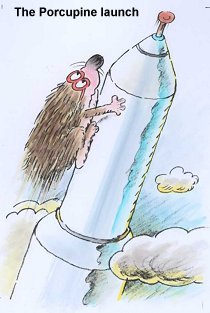 The
magnetospheric science community was also attracted by the prospects of
this mighty sounding rocket. Prof. Haerendel of the Max-Planck Institute
was able to gain support in Germany for an ambitious magnetospheric payload
called Porcupine to be launched by an Aries in the auroral zone,
i.e. from Esrange.
The
magnetospheric science community was also attracted by the prospects of
this mighty sounding rocket. Prof. Haerendel of the Max-Planck Institute
was able to gain support in Germany for an ambitious magnetospheric payload
called Porcupine to be launched by an Aries in the auroral zone,
i.e. from Esrange.
To carry out this very ambitious project Esrange needed to upgrade its flight safety systems. Real-time plots were needed of the rocketís position and its projected impact point at any instant if the flight was terminated at that instant by a "destruct" command from the ground (the so-called IIP = Instantaneous Impact Point). In order to provide this, two redundant tracking systems, the ESRO C-band radar and the SSC-developed "slant-range interferometer" (with a strong tradition dating back to the tracking system work done by the Space Technology Group) were tied together by real-time computers to a new "flight safety centre". This was a major effort for SSC staff at both Esrange and Solna and involved sophisticated subjects such as real-time Kalman filtering for reducing tracking data noise. A special rocket equipped with radio tracking gear was even launched to make a realistic test of the tracking systems in November 1975.
In addition, the Aries (which was launched sitting on its tail on a launch pedestal like a satellite launch vehicle) was sensitive to low temperatures and therefore needed a moveable protective shelter and servicing structure. Such a track-mounted gantry tower, à la Cape Canaveral, was built for Esrange by a local contractor in Kiruna during the winter 1975-76.
The first Porcupine launch took place in March 1976. Ascent seemed normal, and all tracking data indicated a good trajectory, when disaster struck almost a minute after launch, a few seconds before rocket motor burn-out! The rocket exploded, all contact was lost, but evidently the bulk of the wreckage rose to over 400 km altitude and impacted near the nominal point, where it was later found. The cause of the failure and a "fix" for it was found after an intensive study by NASA and its contractors supported by DFVLR (the German space agency) which lasted several months. The "fix" consisted of a heat sink placed on the top bulkhead of the motor. This delayed the heating of this bulkhead long enough for burnout to occur before it failed.
In March 1977, Porcupine 2 was launched with its barium release explosive canisters and plasma physics diagnostic instrumentation. The rocket set a new peak altitude record for Esrange, 454 kilometres. Porcupine 3 and 4 were successfully flown in March 1979.
To secure the future of Esrange, it was not sufficient to cut costs and improve services. An equally important part was to advertise these services on the market, i.e. to the space science community.
One of the methods was to give presentations at scientific conferences. On one such occasion, our representative Sonny Lundin had prepared a slide presentation that combined facts about the technical services of Esrange with a bit of tourist information about life in the Kiruna region. After all, the scientists would expect to spend several weeks there during campaigns! To inject a little humour, he had included a few slides showing nude girls bathing in mountain streams.
Somehow, the projectionist got Sonnyís slides mixed up with those of another, earlier presentation - a very straight-laced and formal German scientific paper! In the midst of diagrams and mathematical formulae, one of Sonnyís bathing beauties would suddenly appear! - Amid the consternation and laughter, Sonny announced: "Actually, those slides are part of my presentation tomorrow at 10 oíclock!". The following morning, the house was packed!
Another of Engströmís initiatives to secure the future of Esrange was to start balloon activities. The first balloon campaign was a joint project between Izmiran (Soviet Union) and CNES (France). It took place in January-March 1974. In total, 20 stratospheric balloons were launched during this campaign called Sambo 1. The campaign was successful and was followed by two additional Sambo campaigns in 1976 and 1982.
The balloons drifted with the winds eastwards to the Ural mountains, where they were taken down by means of a timer-controlled device. Telemetry stations at Esrange, Apatity, Naryan Mar and Vorkuta supported all the balloon flights.
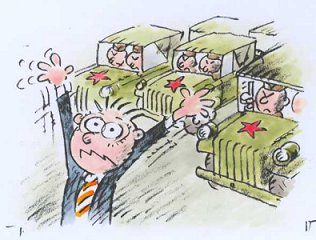 The
staff working at that time at Esrange have many good memories from those
exotic campaigns. The Soviet crew of 15 persons participating in the campaign
arrived in old Russian military trucks. The first time they passed the
border in Karesuando, people were shocked and called the police in Kiruna
to inform them that the Soviet Union was invading Sweden!
The
staff working at that time at Esrange have many good memories from those
exotic campaigns. The Soviet crew of 15 persons participating in the campaign
arrived in old Russian military trucks. The first time they passed the
border in Karesuando, people were shocked and called the police in Kiruna
to inform them that the Soviet Union was invading Sweden!
The cooling system of the cars could not hold glycol mixed with water, so every time the Russians parked the trucks, they had to drain the water, and fill it just before starting the engines again. - One of the guys was evidently there only to ensure that nobody would defect. After a while all Esrange staff knew who he was, because he was always nervous.
The campaigns were very nice, and the Russians were very social and friendly. They often invited us to parties, although their cooking did not always satisfy the Swedish taste. The Russians were very fond of fishing and spent a lot of time fishing from the ice when they had some hours off. They were in fact very skilled fishermen, and they introduced a small blinker called mormyschka among the local population. This jig is nowadays the most popular jig for ice fishing in Kiruna!
They caught a lot of fish which they prepared in different ways in the "hotel Albert" at Esrange. Once they invited Fredrik Engström and some others for supper. They served a typical Russian dish called ocha, a very spicy soup made from small perches, cooked in the soup complete with heads and all the intestines. This was served with white American pork and spirit, a 92 % proof Russian vodka which they had brought from the Soviet Union in large petrol cans. The party started with the singing of Russian and Swedish songs, and the atmosphere was great. Then Fredrik tasted the soup. He got a lot of fish scales and a perch bone in his throat. Fortunately Fredrik recovered quickly after a violent reaction. The Russian spirit may have contributed to his rapid recovery... Anyway, the party carried on far beyond midnight and ended on very friendly terms.
 Another
incident occurred during the first campaign, when one balloon took off
in a completely unexpected direction. We lost contact with it somewhere
over Storuman in Västerbotten. Five days later, the Swedish evening
paper Expressen reported that a farmhouse in Hulån in Dalarna had
been visited by Martians. When the farmer woke up in the morning
and looked out the window, he could see nothing. Then he discovered that
his whole house had been covered with plastic!
Another
incident occurred during the first campaign, when one balloon took off
in a completely unexpected direction. We lost contact with it somewhere
over Storuman in Västerbotten. Five days later, the Swedish evening
paper Expressen reported that a farmhouse in Hulån in Dalarna had
been visited by Martians. When the farmer woke up in the morning
and looked out the window, he could see nothing. Then he discovered that
his whole house had been covered with plastic!
Microgravity research - the sounding rocket pioneers again!
At the end of the 1960s and during the early years of the 1970s, Soviet and U.S. manned spacecraft carried some elementary physical experiments utilising the low-gravity environment in orbit. These experiments involved areas such as electrophoresis (separation of large molecules by electrostatic fields) and metal solidification. The idea behind these experiments was simply that the absence of "gravity" would eliminate hydrostatic forces and therefore suppress liquid motions caused by density differences. Thus, convection in liquid systems like electrophoresis cells or metal melts would be sharply reduced. This would give an opportunity to better control the structure of the metal solidifying from the melt, or in the case of electrophoresis, reduce the lack of sharp separation caused by liquid motion mixing.
When the Swedish space processing effort was started in 1975, materials science in weightlessness was a field of space activity in its very infancy. Early experiments on Apollo and Skylab showed great promise. On account of Swedenís traditionally strong position in materials science, it was natural that the value of this new field for obtaining basic insight into materials processing, and eventually perhaps useful materials in space, should be actively studied within the Swedish space programme.
It was found that the best way to do this was by starting experiments in space as soon as possible. At that time Spacelab was five years away, and very few scientific groups showed any enthusiasm at the prospect of making a few space experiments five years into the future. The only way to provide flight opportunities at an earlier date was through the use of sounding rockets.
In late 1975 a feasibility study of an alloy solidification experiment on sounding rockets proposed by Prof. Hasse Fredriksson (Metal Casting Dept of the Royal Institute of Technology) was started at SSC. In the course of this study, contact was established with DFVLR and the BMFT in Germany who were in the preliminary planning stage of their Texus (Technologische Experimente Unter Schwerelosigkeit = Technological Experiments in Weightlessness) rocket programme.
The German side offered Sweden the opportunity to co-operate in the Texus programme. This was eventually done through the inclusion of a Swedish module in the Texus payload, participation of German scientists in the experimental programme for the Swedish module, and a Swedish contribution to the programme by bearing the range fee and recovery operation costs.
The experimental concept agreed between SSC and Prof. Hasse Fredriksson was to use only alloys with rather low melting points (< 1000 °C) in order to simplify the technical problems involved in designing the furnaces. Existing, commercially available components were used to the greatest possible extent because of the rather short time available for developing the furnaces.
A small in-house team at SSC designed and developed the complete module, including furnaces, over a nine-month period. Its flight weight was 38 kg. The Skylark 7 rocket carrying the first Texus payload was launched from Esrange in December 1977 and reached an altitude of 262 km. During the exo-atmospheric portion of the flight, the rate-control system achieved micro-g levels of < 10-4 g. The payload was recovered in excellent condition.
In November 1978 a second Texus launch was made. The results were included in a Ph.D. thesis by Torbjörn Carlberg of the Metal Casting Dept of the Royal Institute of Technology in Stockholm. He was the first scientist in Europe to win his Ph.D. in the new field of microgravity research.
The Texus series of sounding rocket launches continued, both as a preparation for Spacelab and as a programme in its own right. Up to 1982, seven Texus launches took place, and the Swedish module was flown on five of these.
Sounding rocket technology had again shown its usefulness in quickly meeting new scientific challenges.
The participation in Texus initiated the Swedish microgravity research programme. A new multi-purpose materials science experiment module was developed by SSC and flown as a piggy-back experiment on the PIRAT astronomy sounding rocket in October 1981. The experiments included liquid metal diffusion (from Chalmers Technical University in Gothenburg) cells and porous metal experiments (from Prof. Fredrikssonís institute).
The pore-formation, metal-foam experiments were also flown in NASAís F-104 aircraft for up to 60 seconds of microgravity. SSC performed the role of systems integrator for these experiments.
So, Sweden was giving its contribution to this new application of space technology. Even if microgravity research does not evolve into space based industrial activity it will inevitably contribute to basic insights into materials science. If an industrial "breakthrough" occurs in space, the Swedish microgravity programme could provide an "entrance ticket" to such ventures!
During the 1960s, sophisticated military reconnaissance techniques in the microwave, infrared and visual parts of the spectrum had been opened to civilian use. Meteorological satellites had already made use of these new sensors, and there were advanced plans in the U.S. for the first Remote Sensing satellite (ERTS-1). In Sweden, the National Defence Research Institute (FOA) was experimenting with IR and microwave sensors. Hasselblad had built "the first Swedish satellite" - a camera accidentally dropped in orbit by a U.S. astronaut - and the camera would soon also be used on the Moon. The institutes of physical geography at Stockholm and Lund universities extensively used aerial photography for the study of geomorphology, geology, soil and vegetation.
In April 1969, some foresighted people met to form the STU Remote Sensing Committee (STURSK). It has been told that everybody at that meeting made a short statement predicting the progress to be expected within the coming ten years or so. These statements have been tape-recorded, but mercy has prevented us from giving any details in this exposé.
It would be the task of the new committee to form a Swedish policy in this area, to co-ordinate development work at various scientific institutes and to provide a focus for the efforts of Swedish industry in this area. - Prof. Gunnar Hoppe from the Institute of Physical Geography at Stockholm University was appointed chairman, and the work would start with an initial budget of 150,000 SEK for the fiscal year 1969/70. - In 1970 SSC was awarded 90,000 SEK to provide the secretariat.
What should be done with a limited budget? Hardware is expensive and so are field campaigns. Consequently STURSK started with a couple of industrial studies with the aim to identify the needs within Sweden, the possibilities of using Remote Sensing techniques, and the knowledge and experience within Sweden.
These studies, performed by Saab-Scania, AGA, Boliden and LM Ericsson constituted the bulk of the work during the first years and gave some ideas for the future. Further studies and initial field tests during the early 1970s proved that oil spill monitoring from aircraft was feasible.
At the same time 9,000 SEK was allocated to the development of an "ecological sensor", since long happily forgotten - maybe due to budget restrictions.
In the light of history one man during this period may be pointed out as more important than others for the growth of Remote Sensing in Sweden. This man was - well, let us call him Mr XYZ - the man who the newspapers called an impostor. With nice looking aerial photographs produced with the help of clever but innocent professionals, he tried to convince various authorities that he - and only he - was able to find every possible substance and identify any environmental effect on nature.
Swedish experts, within STURSK and outside, did their best to convince less knowledgeable people that the man was much less than reliable. At the same time they explained what really could be accomplished with proper Remote Sensing techniques. At the beginning of 1972, the story came to an end as Mr XYZ seemingly painted himself in the "invisible paint" he had developed and vanished from the Swedish scene (after a brief stint as sex advisor in the "Lektyr" magazine).
However, the episode pointed out that something could be done with Remote Sensing, that experts were needed for the development, and that the knowledge in Sweden was limited and needed improvement.
In the beginning of 1972 STU was reorganised and Remote Sensing seemed to fit nowhere and everywhere in the new organisation - so STURSK was dissolved and the members dismissed.
Of course this was the right moment of action for the just-established SSC. SSC pointed at the similarities between space and Remote Sensing technology, and at the fact that satellites would become indispensable for Remote Sensing in the future, maybe also within ESA.
Thus, a rational approach would be to put Remote Sensing under the newly formed Swedish Board for Space Activities. This happened, and the Remote Sensing Committee (FAK) of SBSA was formed with Prof. Hoppe as chairman. The committee was built up with experts from various research organisations. Under FAK, advisory bodies were organised for land, water, and atmospheric applications, and for data processing.
What was more natural for SSC - running Esrange - than to start its remote sensing activities with a sounding rocket project? The rocket, a Skylark, was equipped with the only available Swedish space remote sensing instruments - Hasselblad cameras. The aim was vegetation mapping and rangeland surveillance in northern Sweden, with special emphasis on mapping reindeer pasture. The project was carried out in co-operation with Germany and Great Britain.
In the summer of 1973, the day of launch came with clear skies over northern Scandinavia after ten days of bad weather. Prof. Hoppe resolutely pressed the button, the first stage ignited but the second did not. So the rocket impacted close to the launching area and reindeer are still wandering around happily grazing where they always have.
To demonstrate the potential of the new technology to the prospective users, the time period between 1972 and 1976 was filled with field experiments with fancy names like: Oil spill 72, Oil spill 74, MSS 75, Smoke stack 75, Sea ice 75, etc.
In these campaigns all available instruments were gathered to evaluate what could possibly be done with Remote Sensing. Users like the Coast Guard, the Environmental Protection Agency, the Swedish Maritime Authority, the Swedish Meteorological and Hydrological Institute and the Swedish Land Survey were deeply engaged. SSC, as project manager, co-ordinated the vast efforts of many enthusiastic researchers, operators and administrators.
In the spring of 1975, SSC entered into its first commercial venture in the Remote Sensing field. The Swedish Meteorological and Hydrological Institute (SMHI) was looking for an airborne IR-linescanner, to be used primarily for mapping hot water outlets from nuclear power plants. SSC was engaged to make a technical study and market survey. As a result, SSC entered into a commercial partnership with SMHI. SSC financed part of the equipment and operated the system.
Due to, among other things, the diminishing Swedish nuclear power programme, this venture did not turn into a smashing commercial success for SSC, and the system was transferred to the Swedish Land Survey (LMV) in 1982. - On the other hand, the technical knowledge of airborne IR-scanners was ideal for the Maritime Surveillance System. It also gave experience of commercial operations in the Remote Sensing field within Sweden and in developing countries like Zambia (where IR-scanner flights were performed by SSC).
The first dedicated remote sensing satellite ERTS-1 (later renamed Landsat-1) was orbited by the U.S. in 1972, followed by Landsat-2 in 1975 and Landsat-3 in 1978. - Our accountant had the uncomfortable experience of going to the bank to send a cheque to the "EROS Data Centre" as payment for the first Landsat images of Sweden...
A new field of space activities had been opened. How could SSC help Swedish users to exploit the new technology? Three answers to this question could be envisaged:
- Get your own data acquisition station
- Develop digital processing of satellite image data
- Get your own satellite.
Following the success of Landsat-1, data acquisition stations were established around the world. In Europe, the Italians established one at Fucino near Rome. In the spring of 1973, SSC enquired with NASA about the possibility of setting up a Landsat station at the Råö Observatory, but the financing turned out to be difficult to arrange.
A few years later, ESA decided that it should promote the use of Landsat data as a preparatory activity to build support for its own future satellite programmes in remote sensing. It proposed to sponsor a satellite data acquisition and dissemination network, EARTHNET. To this end a station in northern Europe was needed to supplement the Italian one.
Clearly, the time was ripe for SSC to act. The author was appointed project manager to establish a Landsat station at Esrange. The technical manager at Esrange, Björn Eriksson, and the author conducted whirlwind tours of potential suppliers in the late summer of 1976. Various bodies in other European countries were exploring the same opportunity. While they hesitated, the Board of SSC in September 1976 took the formal decision to establish a Landsat ground station at Esrange. Some heated opposition - both domestic and international - followed, but our status as an ESA member in combination with our favourable location, complementary to the Italian station, proved decisive.
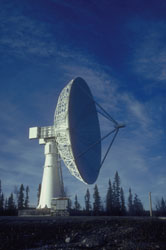 A
year of negotiations with ESA, equipment manufacturers and other parties
followed. During the winter of 1977/78 the now well-known silhouette of
the S-band antenna was seen for the first time at Esrange. Data acquisition
started in May 1978. The full processing chain was installed during the
spring of 1979, and the official inauguration took place in June 1979.
A
year of negotiations with ESA, equipment manufacturers and other parties
followed. During the winter of 1977/78 the now well-known silhouette of
the S-band antenna was seen for the first time at Esrange. Data acquisition
started in May 1978. The full processing chain was installed during the
spring of 1979, and the official inauguration took place in June 1979.
The excellent performance and operational availability of the Esrange Landsat Station turned out to be a powerful argument when its upgrading for future satellites was negotiated, and in particular when the Salmijärvi station was set up.
World champions within a week?
Landsat generated digital image data. Such data called for digital processing to take full advantage of the inherent information.
In Sweden an early start in this field was made at the National Defence Research Institute (FOA). During the period 1974-77 they were deeply engaged in developing processing methods in conjunction with Landsat and the MSS-75 project.
During 1977 SSC studied the future of satellite image processing in Sweden. It recommended that an interactive processing system based on a minicomputer should be acquired by SSC. The idea was strongly resisted by some organisations, who maintained that the use of a software package developed by FOA, and installed on a mainframe computer, was the best solution.
The strong resistance probably had an unintended effect on the Board of SSC: "This must be a promising area for the future, if emotions are so strong?" As a result, SSC was mandated to contract the Canadian company MDA to deliver the Image Analysis System (IAS).
The system was delivered during the 1978 Christmas holiday. SSCís staff, who were at the same time absolutely fascinated with the new tool and anxious to prove that the investment had been justified, did not wait for the end of the holiday to start operations.
 In
line with SSCís reputation for arrogance, and only half in jest, Fredrik
Engström liked to say that we could become "world champions" in
any subject within a week. In the case of digital image processing,
this was in fact not far off the mark, as during the next weeks and months
we developed our expertise in the use of an image processing system that
at the time represented the cutting edge of technology. The system was
put at the disposal of several scientific and user groups in Sweden: VBB,
SMHI, university groups in Stockholm, Uppsala and Lund, etc, contributing
to the spread of image processing expertise in Sweden.
In
line with SSCís reputation for arrogance, and only half in jest, Fredrik
Engström liked to say that we could become "world champions" in
any subject within a week. In the case of digital image processing,
this was in fact not far off the mark, as during the next weeks and months
we developed our expertise in the use of an image processing system that
at the time represented the cutting edge of technology. The system was
put at the disposal of several scientific and user groups in Sweden: VBB,
SMHI, university groups in Stockholm, Uppsala and Lund, etc, contributing
to the spread of image processing expertise in Sweden.
The IAS system also became a mandatory showpiece for visiting VIPs, of which there were many in the days when the Nordsat and Tele-X programmes were under discussion. On many occasions, we managed "just by chance" to have an image of the visiting Ministerís home town on the screen. - On one occasion, our Minister of Industry and future Chairman of the Board of SSC Nils G Åsling and Minister of Education Jan-Erik Wikström visited us. At the very moment they entered the IAS room, the system crashed! Our operator, Sonny Lundin, managed to reboot the system, entering some arcane instructions in hexadecimal code, without even interrupting his welcoming remarks. The Ministers never noticed, but the rest of us were mightily impressed!
Ever since the start of ESA, talks had been going on concerning a possible European Remote Sensing satellite. In 1977, France unexpectedly pulled an almost ready satellite project out of its sleeve - SPOT. In accordance with ESA rules, the project was offered to the other member countries. We thought that the project was very well conceived and managed to convince SBSA and the new "Space Minister" Olof Johansson of its merits.
At the ESA Council of Ministers in February 1977, it turned out that the only country ready to endorse the project was Sweden. This must have been quite an unnerving experience for the young and inexperienced Minister, and I am sure that SBSA had some additional explaining to do after the meeting!
Later, France surprised the other ESA countries by announcing that the project would be carried out as a national project. In recognition of our support, and perhaps to give the project an international flavour, Sweden was invited to participate on a bilateral basis.
During 1978, negotiations led to a Swedish participation in the SPOT project at the four-percent level. Saab-Scania was invited to build the on-board computer. Sweden also obtained the right to acquire data directly from the satellite and the right to use data freely corresponding to our participation in the project.
We enjoyed good support from our Foreign Ministry in the negotiations. They showed remarkable audacity in favouring Swedish participation. The Soviet Union at the time maintained a 50-metre limit on what they considered to be an acceptable resolution for publicly available Earth Observation data. We could easily have been accused of participation in a "spy satellite".
Based on the results from field campaigns like Oil-Spill-72 and -74, SSC started developing an airborne maritime surveillance system in 1975. The work was carried out in very close co-operation with the Swedish Coast Guard. Prototype Side Looking Airborne Radar (SLAR) and IR/UV-scanner systems were installed in two aircraft in 1978.
Two years of performance tests and pre-operational service led to the specification and development of a second-generation operational system. SSC was the prime contractor to the Coast Guard, with subcontracts to Ericsson for the SLAR and Swedair for the installation. In 1981, the Coast Guard took three aircraft equipped with second generation systems into regular service.
The early initiative by SSC and the Coast Guard, and the very tight development budget, led to a situation where SSC was alone on the market with an advanced, operationally proven surveillance system at a reasonable price. This was also recognised by users all over the world. The first system to be sold abroad by SSC was to the Netherlands in 1982.
Esrange Landsat Station was the start. The agreement with France for SPOT followed. Vast experience in image processing and applications of satellite data was gained with the Image Analysis System and the EBBA. The contacts with users gave market knowledge. The question was how to make good use of these resources.
SSC started with a "low profile" idea - creating a Remote Sensing Centre in Kiruna with the capacity to process satellite data on a routine basis for Swedish, and especially regional, needs.
During the course of 1981 it became obvious that a receiving station for SPOT at Esrange was not just a Swedish interest - France needed a full capacity Swedish station to cope with the expected demand for SPOT-imagery, in particular tape-recorded data from remote parts of the Earth.
At the same time SSCís confidence in the coming market for SPOT data and various further processed and enhanced products was confirmed from international market studies and from our own contacts with users.
So why stay modest? Based on our expanding role in the SPOT programme, there was an opportunity to take an internationally leading role in the commercialisation of satellite Remote Sensing.
During an intensive period in 1981, negotiations were carried out in parallel with the Swedish Government, the regional government, the municipality of Kiruna, and with France. An elaborate economical model of an enterprise based in Kiruna was established. A business plan was developed. Finally, in February 1982, when all the pieces of the jigsaw puzzle had fallen into place, the Board of SSC took the decision to establish a subsidiary company, subsequently named SSC Satellitbild. The company had CNES and the newly formed Spot Image as minority shareholders, and SSC became a minority shareholder of Spot Image.
Putting scientific packages onboard orbiting satellites and conceiving satellite systems for science and applications projects must be a technological imperative for any space organisation. For SSC, this urge to prove the value of space technology resulted in a crescendo of increasingly ambitious orbital projects. The first one was the solar UV polarimeter package orbited by the Interkosmos-16 satellite in 1976. Then came the NORDSAT Nordic TV-broadcasting satellite study, the M-SAT plasma research satellite study which led to the development of the Viking satellite, and, starting in 1980, the Tele-X experimental TV and data communications satellite.
SSC's drive to "go orbital" was based on a strong conviction that space technology systems for communications and remote sensing would be part of our societyís basic fabric and technological infrastructure, just like roads, railroads, telephones, broadcasting and airlines. It was therefore natural for a high-technology country like Sweden to be able to design and build major parts of such satellites. To be able to do so, a technology base needed to be built up in Swedish industry. The relatively low-cost, low-risk, scientific satellite projects Interkosmos and Viking should be seen from that perspective, i.e. as technology and experience building efforts, in addition to their scientific objectives.
In 1972-73 the Interkosmos Council of the Soviet Academy of Science and the Swedish Board for Space Activities agreed on a co-operative solar research project conceived by the University of Lund and the Crimean Astrophysical Observatory. The experiment, to be carried onboard a standard satellite in the Interkosmos series, was designed to measure the polarisation of certain spectral lines in the ultraviolet light from the sun. The optics of the experiment, a highly sophisticated design, were made by the Jungner Company. Saab-Scania developed the telemetry encoder which formatted the data for transmission via the Soviet satelliteís telemetry system. SSC developed the UV sensorís signal processing equipment and was responsible for project management, integration and system test, technical and management liaison with Interkosmos and launch site support for the experiment.
The author, as project manager, had some unusual experiences in this project. His very first task was to go to a COSPAR meeting in Madrid for the specific purpose of sizing up his Soviet counterpart, KGB Colonel N S Novikov. - On another occasion he had to book a room in Stockholm for Drs Zhitnik and Pisarenko despite the understandable fear of the hotel manager of being the subject of a practical joke. - In Moscow he had his hotel room searched, and in the Crimea he witnessed a seduction attempt by a female secret agent.
Launch vehicle problems interrupted the first launch attempt in June 1975. A backup experiment unit was brought to the cosmodrome at Kapustin Jar on the Volga in July 1976 by two engineers from SSC and the project scientist, Dr Stenflo. It was successfully launched, and for several months reel after reel of computer-compatible tapes from Soviet tracking sites arrived in Sweden for processing.
Other successful co-operative projects involving Swedish scientific experiments on Soviet satellites were carried out. Two charged-particle experiments designed by the Kiruna Geophysical Institute were flown onboard Soviet Prognoz satellites in 1978 and 1980. These satellites circled the Earth in elongated orbits reaching out to 200,000 km (more than halfway to the Moonís orbit).
Interkosmos-16 and PROMICS gave SSC a modest but important "hands-on" experience in developing and testing satellite equipment - different from sounding rocket technology in its demand for long life, high cleanliness, radiation tolerant components, thermal control, and other rigours of the orbital environment.
All big things begin modestly and inconspicuously! So did NORDSAT. In the summer of 1974 a short SSC memo written by Lars Anderson had been prepared for SBSA. The memo said, in effect, that geostationary satellites in a few years promised to be so powerful and accurately pointed that TV programmes could be beamed down from space to small dish antennas in individual houses.
In late 1974 an intergovernmental study about the possibility of exchanging TV programmes between the Nordic countries was published. Incredible as it may seem today, the possibility of direct broadcast from geostationary satellites was dismissed.
SBSA was invited to offer its comments on the study. It endorsed SSCís view that satellite technology had reached such a state of maturity that direct broadcast satellites could be seriously considered to achieve the objective of inter-Nordic exchange of TV programmes.
The Nordic Council of Ministers decided to give the matter further attention. So, to prove its point, SSC was given the task of substantiating its claim of an imminent advent of direct broadcasting satellites. In the beginning of 1976, SSC was given a small contract (300,000 SEK) by the Nordic Industrial Fund to conduct a one-year study of the matter.
The satellite system would exchange existing TV programmes in Denmark, Finland, Norway and Sweden. It could provide eight TV-channels to every household in these countries. This would truly be a media revolution, since at the time only one or two TV-channels were available to viewers in each of these countries.
SSCís approach to its assignment was straightforward: to get in touch with everyone in the world who might contribute knowledge about the status of the technology needed for direct broadcasting satellite systems. This meant technical exchanges with satellite manufacturers in the United States, namely, Hughes Aircraft Co, TRW Systems, General Electric, Ford Aerospace, and in Europe with Aerospatiale and Matra Espace in France and MBB in Germany. In Sweden, Saab-Scania and Ericsson studied the NORDSAT system under small contracts from SSC, but also invested some of their own resources into the effort like the U.S. and European aerospace companies mentioned earlier.
SSC also engaged the Microwave Institute in Stockholm to study home receiver technology and travelled to Canada and the U.S. to discuss the results of experiments with Japanese 12 GHz home receiver terminals.
With this high-profile project, SSC found itself at the centre of media attention. It was attacked from two sides. The cultural establishment, mirroring prevailing attitudes of the period, dismissed the proposal as a conspiracy by "the electronic-industrial complex" to peddle "electronic dope" to the public in general and children in particular. Some highly respected debaters even wanted to prohibit satellite receivers. [January 20, 2014: My former colleague Sven Grahn has collected several newspaper articles from the heated 1970s Nordsat debate - pro and con.]
Another kind of criticism came from the Nordic telecommunications administrations, who were in general highly skeptical of the claims made for satellite technology. They in particular considered SSCís estimates of the required satellite power levels to be wildly optimistic. Understandably, a heated exchange of views took place.
At one point, following a joint SSC/Swedish Telecommunications Administration (STA) review in the middle of the week, SSC prepared a detailed technical document defending its views over the weekend. Our STA colleagues refused to believe that such an extensive document could have been produced over the weekend and accused us of having withheld information! - In fact, the incident underlines the devotion of our staff, including secretaries, who were ready to sacrifice a weekend when duty called.
On another occasion, amid the conflicting claims and resulting confusion, SSC and STA were invited to produce a joint paper clearly explaining what was agreed and what was contentious. Feelings were running so high that the author, who was considered mild-mannered and relatively "uncontaminated" from previous discussions, was sent over to STA to hammer out an agreement in seclusion with Valdemar Persson, the present Managing Director of Teracom.
Thanks to some judicious lobbying, and the competence and tenacity of some far-sighted individuals in the Ministry of Communications, the world-wide telecommunications conference WARC in 1977 allocated the frequencies needed to make NORDSAT technically feasible. According to rumour, "our" representative nearly got into a fist fight when he tried to adjust some parameters in the frequency allocation computer models in the middle of the night...
With this plan decided, SSC set out to finalise its NORDSAT study in February 1977. The technical report was written by SSC engineers Lars Anderson, Lars Backlund and Sven Grahn in three hectic weeks. The report proposed a space segment consisting of two identical active satellites transmitting four channels each to the East Nordic area and two and three channels respectively to the West Nordic area. An in-orbit spare satellite was also proposed. The report showed that such a system could be launched by the European Ariane rocket then under development as well as by existing or projected U.S. launch systems. The radio-frequency power needed from the transmitting tubes in the satellite for each channel was estimated at 330 W.
After the end of SSCís study, there was a long period of evaluation in the Nordic countries of this report and an accompanying study on the legal, cultural and programming aspects of NORDSAT. After this evaluation period, a further study of the project was decided by the Nordic countries, including a renewed technical evaluation of the space segment. This technical study, led by the telecommunications administrations, was carried out during 1978 and 1979. Meanwhile, SSC was given the task by the Swedish Ministry of Industry to study the industrial policy aspects of the project.
After further extended discussions, NORDSAT was quietly shelved. It appeared that while a consensus on technical issues was slowly emerging, legal and policy issues just became more intractable. To put it bluntly, the political will to establish NORDSAT was lacking.
Still, the great NORDSAT debate had firmly established the social significance of space technology in the public mind. This was one of the two ingredients needed to achieve our "big leap" in 1979.
In 1978, the outcome of the NORDSAT debate was still uncertain. However, it had become increasingly clear that space activities carried great significance in the overall scheme of things, and that therefore Swedenís industrial capability to build space systems must be nurtured and safeguarded.
At the same time, the country was approaching one of the recurring crises in its defence industry. The decision to procure the development of a next-generation fighter plane from Saab had been postponed repeatedly, and it seemed certain that a major contraction and restructuring of the Swedish defence industry was inevitable. This raised far-reaching concerns that the country would also lose much of its "high-tech" competence. How could the talent in the defence industry best be used? - One answer seemed to be to expand the Swedish space industry.
This was part of the background to the "space bill" of 1978, which the Parliament endorsed unanimously in 1979. The "space bill" increased the funding for space activities by a factor of two for the purpose of establishing an industrial capability in Sweden to participate at competitive prices in the production of future space systems needed by Sweden. Such systems foreseen in the bill were mainly telecommunications satellites for TV and/or data services. The strategy foreseen to achieve this was for Swedish industry to team up with industries from other nations to sell space-related products to third parties. The Swedish "home market" would be offered in return for Swedish participation in such joint export endeavours.
To prepare Swedish industry for system-level tasks in such projects, the possibility of using low-cost scientific satellite projects for giving Swedish industry responsibility at systems level was foreseen. Hitherto, only subsystem level tasks in satellite projects had been entrusted to Swedish companies.
This was the background to the decision by the Swedish Cabinet of Ministers in August 1980 to approve the development of the Viking magnetospheric research satellite.
Viking was conceived as a "sounding rocket in orbit". It had to be simple and inexpensive, yet offer the capability to do world-class science.
The idea had its roots in the study of a Swedish satellite project from 1970. It had been brought up again in 1977 as a possible follow-on to the Interkosmos project with the Soviets. A very simple, battery-powered - and therefore short-lived - satellite was envisaged.
Discussions with scientists indicated that there was a "golden opportunity" to do pioneering science in exploring the mechanisms behind the aurora borealis - the Northern Lights. This required a slightly more ambitious satellite than originally foreseen.
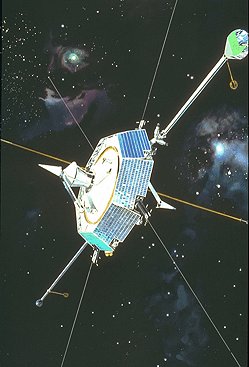 As
the scientific objectives became better defined, it grew evident to SSC
management and engineers that to meet the goal of a satellite cost equivalent
to "about 4-5 sounding rocket projects", i.e. about 20-30 MSEK, the satellite
must be built with very well-known technology and even with existing components
and preferably complete off-the-shelf subsystems.
As
the scientific objectives became better defined, it grew evident to SSC
management and engineers that to meet the goal of a satellite cost equivalent
to "about 4-5 sounding rocket projects", i.e. about 20-30 MSEK, the satellite
must be built with very well-known technology and even with existing components
and preferably complete off-the-shelf subsystems.
The scientists involved in the satellite discussions often mentioned that they had been "inspired" by the research done by the U.S. Air Force magnetospheric research satellite S3-3 launched in 1976. S3-3 was part of the USAF Space Test Program which included a long series of low-cost scientific satellites using off-the-shelf subsystems. These satellites had been made by Boeing Aerospace at low unit costs - a few million dollars per satellite. So, Boeing seemed to have what was needed, a satellite platform for the type of science in question, and possibly at the right price!
Discussions started immediately on the possibility of placing small study contracts with Boeing and Saab and in early 1979 this indeed happened. The project also got a name, M-SAT and the discussions with Boeing and Saab informally established the characteristics of some onboard systems. Unified S-band for TT&C was "chosen" and so were magnetic torquers for keeping the spin axis perpendicular to the orbital plane - a scientific requirement.
While subsystems were being defined, the question of the launch vehicle remained undecided. The original idea of using a Soviet vehicle was dropped due to the difficulty of getting the detailed technical information needed.
Boeing suggested that a projected new version of the Scout booster developed jointly by Vought Corp and the Italian space authorities, the San-Marco Scout, should be considered. This was done, but the plans for San-Marco Scout were not entirely clear.
A third alternative emerged in April 1979. CNES, the French Space Agency, had payload lifting capability to spare in the SPOT remote sensing satellite mass budget. This was quietly being offered for a piggyback "passenger" satellite to interested parties. However, M-SAT would need its own propulsion to reach its final orbit from the SPOT orbit, which was circular at 822 km and 98.7° inclination.
An internal SSC study revealed that a 822-15000 km orbit at the SPOT inclination (98.7°) was well suited to the scientific requirements as they were defined. The apogee of the orbit, if placed initially over the North Pole, would drift to the South Pole in one year. A period of several months in the interesting regions of space could be achieved for any launch date.
The M-SAT study was drawing to a close, and the SPOT launch option had been only briefly examined. M-SAT was also exceeding its price target. - At the recommendation of SSC, SBSA agreed to drop the current configuration of M-SAT and redirect the work to a new configuration based on the SPOT opportunity. The new project name chosen in a great hurry (and suggested by the author) was Viking.
The satelliteís science payload was well-defined, and so were most platform subsystems. The general satellite design philosophy implied the use of qualified, off-the-shelf units but without redundancy. The philosophy of "single-thread" systems was normal for low-cost satellite platforms in the U.S. and promised to give an analytical probability of successful operation over eight months of at least 80%.
Saab-Scania immediately started exploring the new concept based on a preliminary system specification issued by SSC in late September 1979. The first problem addressed during October 1979 was very basic. CNES had established that the "passenger" must be placed below SPOT, just on top of the Ariane payload adapter. However, a very sturdy structure was needed to carry SPOT, essentially a 1.2 meter diameter aluminium tube with a 7 mm wall thickness. How should this be accommodated?
The basic configuration of the satellite was established in January 1980 after many variations had been explored. The definition study of Viking was completed in June 1980, and the negotiations of the development contracts commenced. The satellite as defined would weigh no more than 550 kg, out of which 263 kg would be a rocket motor and 60 kg experiments. Peak solar panel power was estimated at 80 W, and with a 100 W peak consumption science data could be taken for 80 minutes on each orbit. The octagonal satellite design measured 1.8 metres across and the central cylindrical structure was designed to be 0.5 metres high. Telemetry was on S-band at 55 kbits/s.
During the summer of 1980 the contracts for the development were intensively negotiated, and shortly after the Cabinet had decided to approve Viking, they were duly signed in September 1980. The first Swedish satellite project was under way!
As we shall see, Viking was successfully launched on 22 February, 1986. - In many ways, the development of Viking was "the finest hour" of SSCís engineers. It was documented in a film by C-H Svenstedt entitled "De lyckliga ingenjörerna" ("The happy engineers") which was shown in cinemas to the general public.
At the end of the 1970s, the technology needed for telecommunications satellites with several high-power transponders not only made direct broadcasting satellites possible but also opened up prospects for telephone and data communications between many small ground terminals over "subcontinental", regional distances. Even individual countries could approach the market size needed for making satellite communications competitive against terrestrial means; especially in countries where a substantial telecommunications infrastructure had not yet been established.
This new evolution of communications satellite technology represented a qualitatively new development. Communications satellites had earlier only been used for the dense traffic routes across oceans, using relatively huge ground stations where traffic was concentrated from and to a single country or a group of countries.
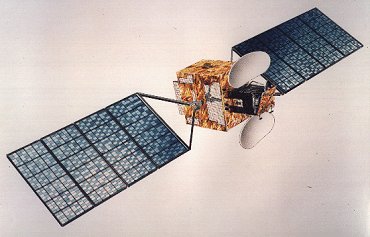 With
the advent of satellites with huge solar cell arrays, high-power travelling
wave tubes and accurately pointed narrow-beam antennas, the time had come
when individual enterprises or industrial plants could be equipped with
their own satellite terminals. Such terminals could be used to provide,
for example, high-speed internal links in corporations or organisations
with many plants or sites of operation. The signalling on these links
could be electronic mail, high-speed facsimile, computer-to-computer talk,
banking operations, video conferences etc.
With
the advent of satellites with huge solar cell arrays, high-power travelling
wave tubes and accurately pointed narrow-beam antennas, the time had come
when individual enterprises or industrial plants could be equipped with
their own satellite terminals. Such terminals could be used to provide,
for example, high-speed internal links in corporations or organisations
with many plants or sites of operation. The signalling on these links
could be electronic mail, high-speed facsimile, computer-to-computer talk,
banking operations, video conferences etc.
Such regional satellite projects were initiated in the U.S. in the shape of the Satellite Business System and in France with the Telecom-1 data communications satellite.
These technological trends also deeply affected Swedish space policy at the end of the 1970s. In the "space bill" of 1979, regional satellite data communications as well as satellite TV were explicitly mentioned as major areas for the application of space technology for Swedish society. Indeed, these prospects were a driving force behind the "space billís" objective of creating a national technological base for producing significant parts of such systems (both in the space and Earth segment).
Consequently, at the end of 1979, SSC started to explore these possibilities in detail, examining together with the Swedish Telecommunications Administration (STA) ideas of varying ambition. By this time, STAís previous mistrust of high-powered communications satellites had diminished. The Nordsat studies carried out by the Nordic telecommunications administrations in 1978 and 1979 had corroborated many of the claims of the previous SSC work, and satellite technology was progressing rapidly. The Swedish Ministry of Industry encouraged a co-operative climate between STA and SSC, even to the extent of asking SSC to supply the Secretary of a government commission on the Swedish aircraft industry chaired by the Director General of STA.
The NORDSAT studies had shown clearly that "heavy" communications satellites in the 1000-kg dry weight class would soon be available in Europe and elsewhere. The studies by SSC and discussions with STA gradually focused on how such a heavy satellite could be used for a purely experimental Swedish communications satellite with a combined payload. It was evident at the time that the interest in satellite-TV broadcasting was still high and warranted the inclusion of two transponders in the satellite for technical experiments with this service, in addition to the data communications experiments.
In the spring of 1980, a feasibility study of such a satellite project was started by SSC for SBSA. STA worked closely with SSC on the definition of the telecommunications mission, and Ericsson and Saab-Scania studied the Earth and space segments of the system. While this study progressed during 1980, two more possible payloads for the satellite were added, a 20/30 GHz wave propagation experiment and a transponder for relaying telex messages to and from mobile stations such as trucks (TRUCKSAT).
The project got its name Tele-X, X for "experimental", during this feasibility phase. At this early stage it only concerned space communications experiments over a Swedish coverage area. The satellite design was based on the TVSAT/TDF-1 platform for which Ericsson and Saab-Scania already developed subsystems (TT&C, OBC from Saab, receiver antenna and Ku-band receiver from Ericsson). To further stress the design-to-cost approach, extensive re-use of equipment from that and other projects was also foreseen for the Tele-X-specific parts, i.e. the telecommunica-tions repeaters and other communications payload parts.
The feasibility study also conclusively showed that a satellite like Tele-X providing several services (TV, data, point-to-point video etc.) was of great interest for the Swedish Telecommunications Administration, despite the fact that Sweden has one of the most extensive terrestrial telecommunications systems in the world. This endorsement was decisive when SBSA sought government approval to go ahead with the next stage of the project, a definition study.
During the definition study, the STA started to work on the project together with their counterparts in Finland and Norway. Finnish and Norwegian industry was interested in taking part in developing the systemís Earth segment and contributing on the equipment level to the satellite.
On this basis, the governments of the three countries started to explore a possible framework for a joint venture in Tele-X, with a view to possible future operational telecommunications satellite systems for the region.
The basic Tele-X mission defined in early 1982 comprised two data/video transponders and two TV transponders. In some operational modes the data transponders could link thousands of small data terminals at offices and plants throughout Norway, Finland and Sweden if Tele-X became part of an operational system. The wave propagation and Trucksat experiments were defined as options.
The definition phase was carried out under SSC overall management by Saab-Scania, Ericsson and SRA in Sweden, and by Thomson-CSF and Aerospatiale in France. In April 1982 the "Tele-X bill" was introduced in the Swedish parliament. Its approval in June 1982 signalled the start for the finalisation of the agreements with our neighbours and the start of the development phase of the project.
In October 1982 a contract for the pre-development phase of Tele-X was signed. In essence this contract started the actual development of Tele-X.
So, out of the ashes of the Nordsat initiative, Tele-X emerged as a reborn phoenix. How could this be explained?
The key undoubtedly was that Tele-X was conceived and presented as a project with a clear industrial policy objective: it was designed to give the Swedish aerospace industry a foothold in an area of strategic importance for the future at the very time when it faced a crisis in its defence business, and its principal mission was to offer improved business communications. Equally important, it was endorsed by the apparent user of any future operational system in Sweden: the Swedish Telecommunications Administration.
Tele-X could be presented and offered for participation to the other Nordic countries on this basis. This vastly simplified negotiations in comparison with Nordsat, where at least two ministries in each country had been involved. Even so, the Tele-X negotiations were by no means simple, and more than once they were on the verge of collapse. In the end, Sweden agreed to participate with 82 %, Norway with 15 %, and Finland with 3 %.
By the time SSC celebrated its 10th anniversary, we felt that we had been successful beyond our wildest dreams. Contrary to many expectations, Esrange had a healthy business in sounding rocket launches that showed no signs of decay. Microgravity research and balloon launches had been added. The Esrange Landsat Station had been established. Our participation in SPOT had created new opportunities for Kiruna, including the establishment of a new company, Satellitbild.
We had developed an airborne surveillance system for the Coast Guard, and successfully introduced it on the world market. A spin-off of this development, the EBBA image processing system, had been well received by Swedish users, and we were optimistic that this could become the start of a new line of business.
We had successfully conducted satellite experiments with the Soviets, and we were now headed for "the big time" with two major satellite projects underway. Our efforts were applauded by the Government, by SBSA, by our scientists, and by industry.
Perhaps the finest tribute was paid by an official in the Finance Ministry, who in a random encounter in an elevator asked: "So, how are things at the Swedish Fireworks Corporation?"
End of Part 2
Go
to Part 1: Ancient history - 1972: How it all began
Go
to part 3: The second decade: 1982 - 1992: Making dreams come true
Go
to Part 4: New horizons: 1992 - 1997: Change in all things is sweet


